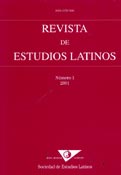Special Hexameters
DOI:
https://doi.org/10.23808/rel.v5i0.87926Keywords:
Metrics; Hexameter; AnomaliesAbstract
A study of the ancient doctrine about the anomalies of the hexameter.Downloads
References
CHRIST, W., 1879: Metrik der Griechen und Römer, Leipzig.
COURTNEY, E., 1932: Musa lapidaria. A Selection of Latin Verse Inscriptions, Atlanta, Georgia.
CRUSIUS, Fr., 1967: Römische Metrik. Eine Einführung, neu bearbeitet von Hans Rubenbauer, München, (8. Aufl.).
DEL CASTILLO, M., 1990: La métrica latina en el siglo IV . Diomedes y su entorno, Granada.
DEL GRANDE, C., 1960: La metrica greca, Torino.
DE NEUBOURG, L., 1986: La base métrique de la localisation des mots dans l ́hexamètre latin, Bruxelles.
DREXLER, H., 1967: Einführung in die Römische Metrik, Darmstadt.
FERNÁNDEZ, C., 1988: Poesía epigráfica latina, I, Madrid.
GIL, J., 1987: «Epigraphica hexas», Filologia e forme letterarie. Studi offerti a F. della Corte, IV, Università degli Studi di Urbino, pp. 419-420.
GIL, L., 1963: «Lengua y metro: La lengua homérica. El verso épico», en Gil, L. (ed.), Introducción a Homero, Madrid, pp. 159-198.
GUZMÁN, A., 1997: Manual de métrica griega, Madrid.
KALINKA, E.,1937, «Bericht über die griechisch-römische Metrik und Rhythmik im letzten Vierteljahrhundert» (Fortsetzung zu Bd. 250, S. 290-294), JAW 257. Bd., 63-3 (1937), pp. 1-160.
KOLAR A., 1947: De re metrica poetarum Graecorum et Romanorum. Accedit de solutae orationis apud Graecos et Romanos eurythmia appendix, Pragae.
KOSTER, W. J. W., 1962: Traité de métrique grecque, Suivi d’un précis de métrique latine, Leyde (3 e impress. corrigée).
LEO, Fr., 1889: «Die beiden metrischen Systeme des Altertums», Hermes 34 (1889), pp. 280-301.
LEONHARDT, J., 1989: «Die beiden metrischen Systeme des Altertums», Hermes 117 (1989), pp. 43-62.
LUQUE MORENO, J., 1984: «Niveles de análisis en el languaje versificado», en Satura grammatica in honorem F. Rodríguez Adrados I Madrid, pp. 287-299.
——, 1984b: «Sistema y realización en la métrica latina: bases antiguas de una doctrina moderna», Emerita 52/1 (1984), pp. 33-50.
——, 1995: De pedibus, de metris. Las unidades de medida en la rítmica y en la métrica antiguas, Granada.
——, 2001: «Un sistema de signos para el análisis métrico de textos latinos en verso», Florentia Iliberritana 12 (2001), pp. 267-294.
MÜLLER, L., 1894: De re metrica poetarum latinorum praeter Plautum et Terentium libri septem, Leipzig (= Hildesheim, 1967).
PARKER, L. P. E., 1976: «Catalexis», Classical Quarterly 26 (1976), pp. 14-28.
PIGHI ., G. B., 1968: La metrica latina, Torino.
RAVEN, D. S., 1962: Greek Metre. An Introduction, London.
RAVEN, D. S., 1965: Latin Metre. An Introduction, London.
RUPPRECHT, K., 1950: Einführung in die Griechische Metrik, München (3. a ed.).
SCHRÖDER, O., 1929: Nomenclator metricus, Heidelberg.
SCHULTZ, G., 1885: Quibus auctoribus Aelius Festus Aphthonius de re metrica usus sit, Vratislaviae.
SCHULZE, W., 1892: Quaestiones epicae, Gütersloh (=Hildesheim, 1967).
SNELL, B., 1962: Griechische Metrik, Göttingen (3., erweiterte Auflage).
STUDEMUND, G., 1886: Anecdota varia Graeca musica metrica grammatica, Berlin.
VOLLMER, F., 1917: Zur Geschichte des latenischen Hexameters: Kurze Endsilben in arsi, München (Sitzungsb. Bay. Akad. Wiss. München, phil.-hist. Kl. 1917/3), pp. 3-59.
WEST, M. L., 1982: Greek Metre, London.
——, 1982b: «Three Topics in Greek Metre», Classical Quarterly 32/2 (1982), pp. 281-297.
WESTPHAL, R.-ROSSBACH, A., 1867: Griechische Rhythmik und Harmonik nebst der Geschichte der musischen Disziplinen, (2. a ), Leipzig.
WESTPHAL, R.-GLEDITSCH, H., 1889: Theorie der musischen Künsten der Hellenen, vol III 2: Griechische Metrik, Leipzig.
Downloads
Published
How to Cite
Issue
Section
License
Copyright (c) 2005 Revista de Estudios Latinos

This work is licensed under a Creative Commons Attribution-NonCommercial-NoDerivatives 4.0 International License.
The originals published in the printed and electronic editions of this journal are the property of the Revista de Estudios Latinos and can be circulated as long as the original source and authorship is made clear in any reproduction, full or partial, of the same, and as long as this is not done for commercial purposes.






